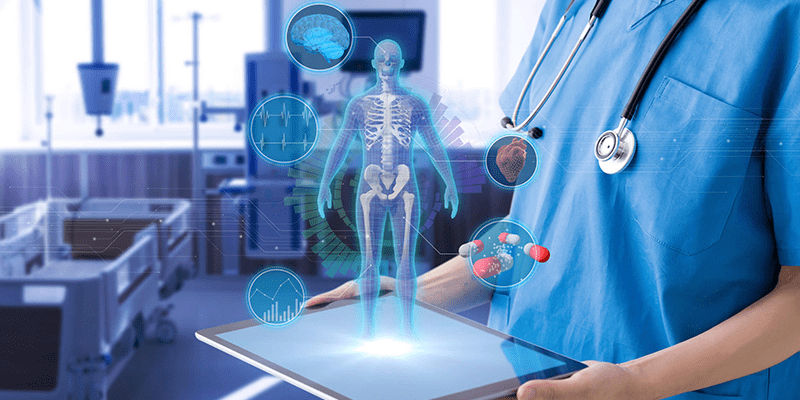Technology is changing the workplace at a fast pace. It's bringing us closer to our devices and making us more connected, but it also poses some risks. For example, cyber-attacks are on the rise and AI-enabled technologies can be exploited by hackers for malicious purposes. Fortunately, there are many ways that organizations can protect themselves from these threats and make sure they're using AI intelligently to keep their businesses safe.
The U.S Government Accountability Office carried out an assessment to evaluate the use of Artificial intelligence in health. The report's conclusions include the fact that AI-enabled solutions have demonstrated potential in both administrative and clinical applications. Among other possible benefits, using these tools could enhance patient care, relieve provider workloads, and boost resource efficiency in healthcare facilities.
Healthcare providers are facing several challenges to better serve patients. As the cost of healthcare continues to increase, more and more providers are turning to digital transformation as a way to improve care and reduce costs. Automation has been identified by experts as one of the most promising ways for physicians and hospitals to improve efficiency in healthcare facilities across the country. Recognizing this opportunity, some organizations have implemented intelligent automation solutions that streamline administrative tasks for clinicians, reduce errors caused by misaligned data, and improve transparency among staff members. In this article, we'll explore why intelligent automation is so beneficial for healthcare providers, how it works in practice (and what it looks like when deployed), and ultimately how you can use it in your organization too!
Controlling of Costs in the Healthcare Industry
Healthcare providers are trying to control costs. They want to do so to maintain the quality of their services and make sure that they can keep up with the rising demand from patients.
Automation is one way for healthcare providers to achieve these goals, but it's not always easy or obvious how exactly it will help them with cost control. For example:
- Automation can help reduce paperwork by automating some processes like billing or patient registration, which would otherwise require manual intervention by an employee (or employees). This saves time and money because fewer people need to be hired/retrained/further trained just as long as those who remain are fully capable of handling the workload without any issues arising later on down the road when someone else needs their help (or vice versa).
- Another benefit associated with automation relates directly back to reducing overall costs related specifically towards administrative expenses such as salary checks etcetera - there's no need anymore because everything has been automated away already!
Harmonizing patient data is scattered across multiple systems
In today's healthcare system, patient data is scattered across multiple systems. This makes it hard for caregivers to access the information they need, and it also makes it hard for caregivers to share patient data with other caregivers. As a result, medical errors are common—and not just in hospitals where there are more opportunities for human error. Caregivers are overburdened with administrative tasks that take up their time away from providing the best possible care for patients in need. Automation can help reduce the time spent on administrative tasks by automating many of them through artificial intelligence (AI) technology or machine learning algorithms that help automate repetitive tasks such as financial management or supply chain management; however, digital transformation is necessary if we want our healthcare providers to focus on giving us better care rather than managing paperwork!
Reduces human error
Human error is a leading cause of patient harm. The World Health Organization estimates that more than 1 million people die each year due to medical errors, and many more suffer serious injuries or are left permanently disabled by them. In the US alone, it's estimated that nearly 200k people experience avoidable harm from hospital-acquired infections each year—and those numbers don't include preventable deaths caused by medication errors or adverse drug reactions.
While there are many ways to reduce human error in healthcare—from educating staff on how not to make mistakes (like double-checking patient identification numbers) to implementing stricter guidelines around prescribing dangerous medications—one-way automation can help improve safety is by reducing the frequency with which these types of mistakes occur: Automation allows for faster processing speeds than humans can manage with their limited attention spans; this means fewer chances for mistakes when completing repetitive tasks like charting patient data into databases or writing up orders over time! It also means fewer opportunities for fatigue from having multiple tasks running at once while trying not to lose focus while working through them all properly
Increases productivity
Automation can be used to reduce the number of manual tasks that healthcare professionals need to perform. For example, it may be possible to automate a repetitive task such as entering patient information into a database or paper form. Similarly, automation can also be used to handle more complex tasks that are too complex for manual processing by healthcare workers.
Automation has been proven time and time again as an effective way of increasing productivity in healthcare settings across all industries; however, there are still many unanswered questions about how best practices should be implemented within each sector (e.g., hospitals vs clinics).
Allows expert employees to focus on more complex tasks
The best part of automation is that it allows experts to focus on more complex tasks. In the healthcare industry, where complex procedures are required and training can be expensive, having a system that automates routine tasks saves money while also allowing experts to focus on more complex ones.
The healthcare industry has many experts in-house who are valuable resources but limited within any organization. By automating routine tasks through process automation and removing them from their hands, you'll free up these valuable human resources for higher-value work like research and development (R&D).
Delivers more accurate, timely results
Modern automation technology is designed to reduce human error and increase the accuracy, timeliness, and reliability of healthcare data. This can be accomplished through:
- Automation of data entry tasks by replacing humans with computers. This reduces errors in handling patient information, such as spelling errors or wrong formatting of dates or numbers. It also reduces the time it takes for users to enter information into a system because there’s no need for them to review what they have typed before submitting it again.
- Using multiple sensors (such as thermometers) that monitor temperature levels throughout the day so that you can see if anything needs attention right away (elderly patients may have high fevers). These sensors could then trigger an alert if something unusual happens on their charts; this would allow medical staff members who might otherwise miss these signs due lack thereof resources available at any given moment within busy hospitals during critical times like those which occur during flu season when thousands upon thousands people visit emergency rooms every week seeking treatment from physicians who may not even get enough sleep between shifts while working long hours without breaks during peak hours between Monday through Friday evenings until midnight Saturday nights only allowing employees two hours off per week which means many cannot afford childcare services unless they're lucky enough still managed to work full-time jobs which often aren't feasible due costs associated with childcare fees etc...
Digital transformation is the key to solving these problems
Digital transformation means using technology to move from a traditional, siloed approach to healthcare that relies on paper-based records and outdated systems, to an integrated digital platform that uses data from patient care and other sources for decision support.
The benefits of digital transformation include:
- Reduced costs by automatically detecting errors before they occur;
- Improved care because patients receive consistent treatment across providers
- Increased efficiency through better use of resources including patient information systems (PIS), clinical trials tracking software, lab results management systems, and employee training materials
- Improved quality by automating processes such as electronic order entry for medications or laboratory results processing so nurses don't have to spend hours entering information manually into computers at different locations throughout their day
- Reduced burden on caregivers who are now freed up from administrative tasks like filing paperwork or updating charts every time someone goes into surgery - all while still providing excellent customer service!
Automation can reduce medical errors and improve care.
The key to intelligent automation is the elimination of errors in your processes. When there's an error in a
system, it must be corrected immediately—but with intelligent automation, this isn't necessary because errors are detected quickly and automatically corrected before they become visible to patients or healthcare workers at all! Using intelligent automation also allows your employees better focus on higher-value work that requires more complex thinking skills than simple routine tasks such as filling out paperwork or changing bedpans (which are easily automated). This gives them more opportunities for career growth within their organization as well as increased earning potential by helping them move up within its ranks over time
Finally, intelligent automation provides new opportunities for collaboration between patients, their families, or loved ones who are involved with their treatment plan at various stages along its development cycle—from pre-surgery through rehabilitation after surgery--and caregivers who may not have access directly due to geographic location or other reasons like lack of internet connectivity inside a facility where patients live during hospitalization periods when they're undergoing outpatient treatments after surgery."
Conclusion
The healthcare industry is undergoing a digital transformation that will help improve patient care and reduce costs. This process is already underway, but it needs to be accelerated to meet the needs of today’s patients, individuals who are increasingly mobile and want to send health data via their mobile devices. With intelligent automation, IT departments can harness the power of AI to make these digital transformations happen more quickly, with less effort on the part of staff members who are working day-to-day with outdated systems that don’t support them well enough anymore.
Healthcare organizations can benefit from intelligent process automation, as it will save time and money. The implementation of this technology is also a good way to improve the quality of patient care by reducing human error and increasing productivity.





